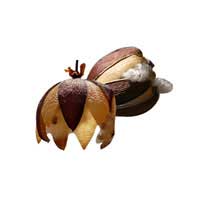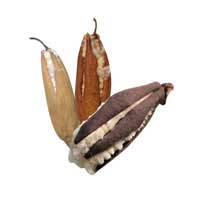 Full List of Fruits
Full List of Fruits  Kapok Fruit
Kapok FruitKapok Fruit
Scientific name - Ceiba pentandra
Indigenous to Mexico, Central America and the Caribbean, with a scientific name of Ceiba pentandra, the kapok tress is known by several other names like Java cotton, Java kapok, silk-cotton or ceiba. Often described as majestic, it has its roots in Malvaceae i.e. from the family of Malvaceae and this tropical tree is found throughout the Neotropics.
The fruits of Ceiba are up to 20 cm long and feature a large ellipsoid capsule. It is during the season of spring and summer, these capsules gets matured and splits into five different divisions discharging the feature "silk cotton". Its five forested valves when split open exposes the fluffy abundance, in which countless black-brown seeds are rooted. With 1.5 - 3 cm long, the fibers of the kapok are detached to the seeds and it is its waxy substance that helps in their water-repellency. With 2 inches in diameter, they have tapered ends. Although 20 cm long, sometimes they are 4 to 8 inches long. The black seeds found within the capsules are dispersed by the wind widely. Even before settling or taking roots, the kapok allows the seeds to parachute or float for longer period of time. Seeing that, they are a giant in the rainforests, it towers high over the other rainforest vegetation.
![]() Nutritional Value of Kapok Fruit
Nutritional Value of Kapok Fruit
| Vitamins | value |
| Moisture | 47.37% |
| Protein | 16.81% |
| Carbohydrate | 25.23% |
| Fibre | 4.47% |
| Fats | 2.23% |
| Ash | 2.14% |
| Vitamin A | 2.323µg/g |
| Vitamin C | 0.6863mg/100g |
| Vitamin E | 1.8836mg/100g |
Given that, the unopened fruit will not go under water when submerged in water, people believe the Kapok fruit floated its way from Latin America to Africa.
The uses of ceiba are widespread. Not suitable for furniture, the wood of ceiba is soft and light and thus used commercially for plywood and pulpwood. Ceiba seeds are rich in oil with a 26% protein and the edible oil is also used for soap and lighting. On the other hand, the "seed-cake" available after pressing for oil can be used to feed domestic animals. Kapok is mainly used for stuffing pillow, lifebuoys, life-jackets, mattresses, saddles, sleeping bags and protective clothing. Still used in many parts of the world, in Indonesia almost half of the population sleep on kapok mattresses.
![]() Health benefits of Kapok Fruit
Health benefits of Kapok Fruit
Depending on where it grows, it has several medicinal uses. While an infusion is used as mouthwash, outermost layers of the stem i.e. the bark is used for asthma, in Philippines they are regarded useful for fever, as a diuretic, for diarrhea and as a purgative. The infusion, apart from being used as an oral rinse, it is also used for coughs, hoarseness, catarrh and uterine discharge. Gum from the bark is found useful for wound healing. Clinical studies have also shown that the stem bark has liver protective properties.
Harvesting kapok requires a large amount of work in relation to output. There are two steps to collect unopened pods, in general, they are harvested by knocking them off the tree, and however they can also be cut from the tree or reaped when they fall to the ground. As soon as the harvesting is done, the fruits of Kapok are hulled by hands to remove the seeds and fibre. In the floss, the seeds lie baggy; hence it is quite easy to collect them as they fall by beating. As a source of timber, it is its main current use. Approximately 15 kg of fibre/ year can expected from a fully grown plantation tree.


















